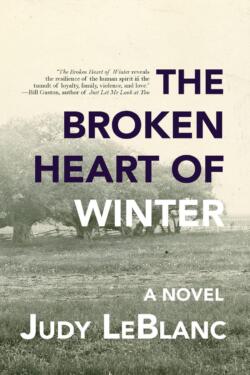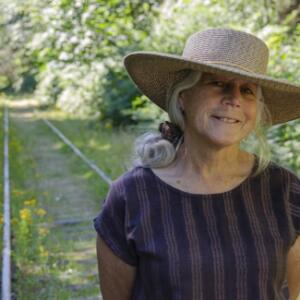1861 ‘Only connect’
The Broken Heart of Winter
By Judy LeBlanc
Qualicum Beach: Caitlin Press, 2023
$24.95 / 9781773861050
Reviewed by Carole Gerson
*
 E.M. Forster’s well-known phrase, “Only connect … Live in fragments no longer,” could well serve as the epigraph to The Broken Heart of Winter, Judy LeBlanc’s novel about the need to connect with family and the past in order to proceed smoothly into the future.
E.M. Forster’s well-known phrase, “Only connect … Live in fragments no longer,” could well serve as the epigraph to The Broken Heart of Winter, Judy LeBlanc’s novel about the need to connect with family and the past in order to proceed smoothly into the future.
These days, recognition of mistreatment, especially that inflicted by post-Confederation governments in Canada, is a common theme in literature that probes the historical marginalization of many ethnic and cultural groups. One story that remains in the shadows reaches back further, to colonial days, when the British expelled the Acadians from their flourishing agricultural communities in Atlantic Canada in 1755. While those who were exiled were later romanticized in Longfellow’s epic poem Evangeline (published in 1847 by an American who never set foot in Acadia), little attention has been paid in English-speaking Canada to those who escaped detention and took refuge in areas that were much less viable than the rich farmland of Grand Pré.
My own grasp of this topic has been significantly enhanced by the pages devoted to “Acadian Deportation and Return” in Volume One of the Historical Atlas of Canada, where Plate 30 pinpoints the scattering of survivors in tiny communities along the New Brunswick coast and the south shore of Cape Breton, the locale that concerns the characters in this novel.
In luminous prose, LeBlanc, a BC native whose surname attests to her Acadian heritage, presents the story of Le Grand Dérangement in three separate narratives. LeBlanc links them by the recurring presence of a Charleville musket, an eighteenth century French gun that was well used in historic times and later preserved as a family keepsake. This gun is also a recurring visual motif on the book’s title page and subsequent interleaves. It instigates the first narrative, set in 2001, when Lise’s estranged son, Daniel, is arrested in Nova Scotia for possession of a firearm.
Living in Victoria where she maintains a carefully reserved demeanour as she reconstructs her life after the disappearance of her son and the failure of her marriage, Lise quickly takes a symbolic flight across Canada once Daniel is known to be in Cape Breton, hanging out with the remnants of his maternal grandfather’s family. Here, his goal is to reconnect with his faded Acadian heritage by rebuilding the dilapidated family home.
The two subsequent narratives occur in reverse chronological order, focussing on Acadian women who maintained their starving families while their men were imprisoned or otherwise absent. Part Two, which takes place on Isle Madame in 1832, presents the outcome of the traumas of Part Three, set in Acadia from 1755 to 1763. While this structure underscores the notion that one has to voyage back in order to move forward, the reader might find that the story is better understood when these sections are read in chronological order: the earlier narrative focuses on Anne as a resourceful wife and mother struggling to feed her children during wartime. The later narrative recounts the end of Anne’s life, at the age of one hundred, and centres on her feisty grand-daughter, Appoline, who has inherited both her grandmother’s resilience and her gun.

Towards the end, LeBlanc posits that even when subsequent generations lose their ancestral history and language, “what [they] will know is exile, which conceals itself in a small, hard husk in the soul and is passed from one generation to the next.” While this image reflects the analysis (associated with Northrop Frye) that a consistent archetype of Western literary culture is a narrative of expulsion and return, I find these words rather troubling: to me, they suggest that in a settler country like Canada, nearly everyone harbours a justifiable sense of exile from some external origin. This pattern manifests congenially in such nostalgic events as Robbie Burns celebrations, but it can also lead to violence when old conflicts later resurface. Moreover, this novel never asks about the inhabitants of the Maritimes who were there before the arrival of the Acadians. The Mi’kmaq are characterized as helpful allies of the Acadians and one Acadian man has a Mi’kmaw wife, yet the Acadians themselves are not presented as intruders, but rather as justified residents who envision defeating the English so that “the land will be left for the Acadians and the Mi’kmaq.”
This novel’s inconclusive ending fits its somewhat fragmentary structure. Having reconciled with his mother, Daniel remains in Cape Breton, planning to link with the local Acadian community for their annual tintamarre festival. The book’s title comes alive with Daniel’s last words–“Uncle Derry says that when you hear the saw-whet owl, the heart of winter is broken”—and suggests that for Daniel, his family’s winter of disconnection is now over. There is less closure for his mother, who returns to Victoria and her uncertain job in a bakery. Here, Lise is reminded of the fragility of “home” when her fellow employee, an immigrant from Vietnam who had tried to return to his homeland, comes back to Canada after failing to reconnect with his brother.
It is this man, Ton, who utters the final spoken words of the novel, “No home,” to which Lise offers no answer. Instead, she continues with her task of kneading dough in order to master the task at hand, her best recourse under the circumstances.
*

Dr. Carole Gerson (FRSC) is Professor Emerita in the English Department at Simon Fraser University. Co-editor of volume 3 (1918-1980) of History of the Book in Canada / Histoire du livre et de l’imprimé au Canada, she has published extensively on Canada’s literary and cultural history with a focus on early Canadian women writers, from well-known figures such as Pauline Johnson and L.M. Montgomery to more obscure figures who can be found in her two databases: Canada’s Early Women Writers and the more inclusive Database of Canada’s Early Women Writers. In 2011, her book, Canadian Women in Print, 1750-1918, won the Gabrielle Roy Prize for Canadian criticism. In 2013 she received the Marie Tremaine medal from the Bibliographical Society of Canada. Her most recent book, co-authored with Peggy Lynn Kelly, is Hearing More Voices: English-Canadian Women in Print and on the Air, 1914-1960 (Ottawa: Tecumseh Press, 2020). She reviewed Dede Crane in BCR.
*
The British Columbia Review
Interim Editors, 2023-24: Trevor Marc Hughes (non-fiction), Brett Josef Grubisic (fiction)
Publisher: Richard Mackie
Formerly The Ormsby Review, The British Columbia Review is an on-line book review and journal service for BC writers and readers. The Advisory Board now consists of Jean Barman, Wade Davis, Robin Fisher, Barry Gough, Hugh Johnston, Kathy Mezei, Patricia Roy, Maria Tippett, and Graeme Wynn. Provincial Government Patron (since September 2018): Creative BC. Honorary Patron: Yosef Wosk. Scholarly Patron: SFU Graduate Liberal Studies. The British Columbia Review was founded in 2016 by Richard Mackie and Alan Twigg.